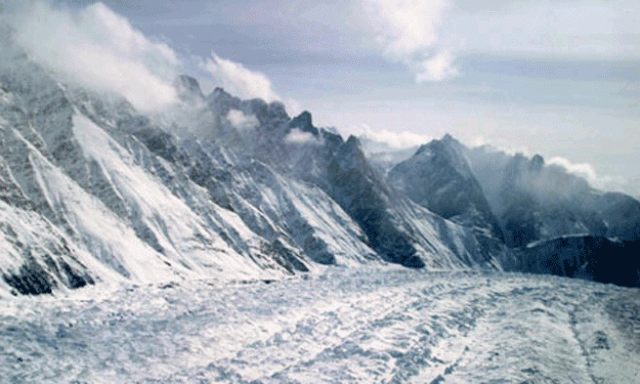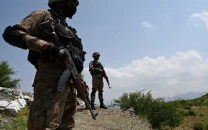Pakistan's glaciers melting faster than rest of the world
Pakistan is listed among countries highly vulnerable to the adverse impacts of climate change

PHOTO: PPI
Pakistan is listed among countries highly vulnerable to the adverse impacts of climate change due to its diverse topographic and demographic settings.
The country is vulnerable to a host of natural hazards particularly of hydro-meteorological nature, the frequency and intensity of which has increased due to climate change. The survey notes the recurring extreme events, including flash floods, cyclones, heat waves, droughts, glacial lake outburst floods and intrusion of saline seawater into the Indus River Delta Region, that Pakistan has faced in the recent years carried significant climate change footprints.
According to the survey, Pakistan suffered economic losses of more than US$15 billion during floods of 2010 to 2012.
The unprecedented floods of 2010 were described by UN Secretary General Ban Ki-moon as a slow moving Tsunami. More than 20 million people were affected and roughly 300,000 were displaced.
Climate change is severely impacting the development aspirations of almost all developing countries.
Read: Climate change: How to cope with the heatwave in the future
The sustainable development prospects of Pakistan are undermined by climate change in multiple ways which is already entrenched with numerous economic, security and social challenges. While Ministry of Climate Change is working to avert these challenges for Pakistan, climate change is serving not only as a threat but also a threat multiplier. Above all, it is seriously undermining the gains achieved in this regard.
Further, it is inflicting huge losses to human life and property and is also causing additional stress on the sustainability and access to natural resources both for the present and future generations.
The actions to address climate change should ensure the sustainable development and sustained economic growth of the developing countries and the universal elimination of poverty, hunger and disease. In Pakistan alone, additional $6 to $14 billion are required annually to adapt to the climate change adverse impacts. Pakistan's greenhouse gas (GHG) emissions are low compared to international standards. In 2008, Pakistan's total GHG emissions were 310 million tonnes of CO2 equivalents.
As such, the most important targets for mitigation efforts focused on reduction of GHG emissions are the energy and agriculture sectors. In the energy sector, integration climate change and energy policy objectives are particularly important. The buildings and transport infrastructure put in place today should meet the design needs of the future.
In light of this, greater attention must be paid to energy efficiency requirements in building codes and long - term transport planning. Further, the framework for the implementation of the national climate change policy (2012) is developed keeping in view the current and future anticipated climate change threats to Pakistan's various sectors.
Read: Food security at risk: Climate change hitting poor the hardest, says minister
In view of Pakistan's high vulnerability to the adverse impacts of climate change, in particular extreme events, the vulnerabilities of various sectors to climate change have been highlighted and appropriate adaptation actions spelled out. These cover actions to address issues in various sectors such as water, agriculture, forestry, coastal areas, biodiversity, health and other vulnerable ecosystems.
Notwithstanding the fact that Pakistan's contribution to global greenhouse gas (GHG) emissions is very small, its role as a responsible member of the global community is very important in combating climate change in sectors such as energy, forestry, transport, industries, urban planning, agriculture and livestock.
Furthermore, appropriate actions relating to disaster preparedness, capacity building, institutional strengthening; and awareness rising in relevant sectors is also a part of this framework for implementation of National Climate Change Policy which has been developed not as an end in itself but rather a catalyst for mainstreaming climate change concerns into decision making that will create condition for integrated climate compatible development processes.
It is therefore, not a stand-alone document but rather an integral and synergistic accomplishment to future planning of the country. Despite being a low GHG emitter, Pakistan is bearing the brunt of climate change related disasters at a high cost to its economy. It therefore, requires concerted efforts to adapt to the adverse impacts of climate change. Number of measures are in focus to address both mitigation and enhancing various ongoing efforts and initiating new activities such as Adaptation Strategies, Mitigation Strategies, Clean Development Mechanism and Nationally Appropriate Mitigation Actions.
The Pakistan Environmental Protection Agency in coordination with International Union for Conservation of Nature, ICUN and other partners had recently conducted the National Impact Assessment program (NIAP). The programme aimed to contribute to sustainable development in Pakistan through strengthening the environmental impact assessment process introducing Strategic Environmental Assessment (SEA) in national development planning.
Based on the experience of NIAP, it is expected that interventions at the policy level through introduction of SEA, capacity building, development of tools, procedures and mechanisms and improved understanding of impact assessment processes, principles of sustainable development could be introduced into country policies and programmes.



















COMMENTS
Comments are moderated and generally will be posted if they are on-topic and not abusive.
For more information, please see our Comments FAQ